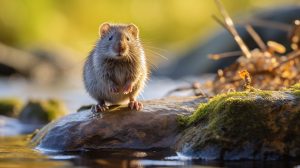Saving Voles
Preventing Roadkill of Our Smallest Neighbours
Voles are often overlooked because of their size, but these little mammals are an essential part of our natural world. Sadly, countless voles lose their lives on roads every year, often unnoticed. By understanding their importance and taking practical steps, we can protect voles and make our roads safer for wildlife.
Meet the Vole
Voles are small, round-bodied mammals, often mistaken for mice. They have short tails, furry faces, and an endearing, busy way of moving about. Despite their size, they play a big role in nature:
-
Busy foragers – Voles spend their days collecting grasses, seeds, and roots to feed their families.
-
Soil helpers – Their burrows aerate the ground, helping plants to grow.
-
Keystone prey – Owls, kestrels, stoats, foxes, and other predators rely heavily on voles for food. Without voles, many of these species would struggle to survive.

They are family-oriented, living in burrow systems and weaving small runways through grasslands. But when roads cut across their habitats, voles are forced into dangerous crossings they often cannot survive.
Why Voles Fall Victim to Roadkill
-
They are small and fast – Drivers rarely spot voles in time.
-
Roads fragment habitats – Cutting across fields and meadows, roads separate vole populations, forcing them onto tarmac to search for food or mates.
-
Verges attract them – Grassy roadsides provide tempting food, but bring voles perilously close to cars.
How We Can Reduce Vole Roadkill
1. Build Safe Crossings
-
Install wildlife tunnels or culverts under roads so voles can cross unseen by drivers.
-
Use small guiding fences (10–20 cm high) to direct voles towards these safe tunnels.
2. Manage Roadside Verges Responsibly
-
Keep grass short near road edges so voles are less likely to forage there.
-
Encourage denser vegetation further from the road, drawing voles away from traffic.
-
Avoid mowing during spring and autumn, when vole activity is at its peak.
3. Reduce Habitat Fragmentation
-
Plant hedgerows and green corridors that link vole habitats without forcing them to cross roads.
-
Create wildlife strips in farmland parallel to roads, giving voles safe movement routes away from vehicles.
4. Raise Driver Awareness
-
Place “Wildlife Crossing” or “Small Mammal Crossing” signs in rural areas with high vole activity.
-
Encourage slower driving on country lanes, especially at dawn and dusk, when voles are most active.
5. Support Local Action
-
Encourage councils to adopt wildlife-friendly road designs in both new and existing roads.
-
Join local groups to record roadkill hotspots, highlighting areas in need of crossings or barriers.
-
Take part in community verge-care projects, which make roadside habitats safer for voles and other wildlife.
Why It Matters
Protecting voles from roadkill is about more than saving small lives. Every vole is part of a bigger picture: they sustain predators, shape soil health, and help balance ecosystems. A road safe for voles is also safer for hedgehogs, amphibians, and many other small animals.
By making small changes to how we drive, design roads, and care for verges, we can ensure that these quiet little creatures continue to thrive in our countryside.
✅ In short: Helping voles cross roads safely means protecting biodiversity, supporting predators, and keeping ecosystems in balance. Every small action adds up — and together, we can make a big difference for the smallest of neighbours.